Fishes are incredibly adorable creatures, especially those fish with big eyes. These aquatic animals can be great pets since they don’t require any training, grooming, or playtime.
What are the types of fish with big eyes? Some of the interesting-looking fishes with big eyes are blue sharks, rockfish, Genie’s dogfish, spotted ratfish, bigeye fish, and many more. Some of these fishes are good as pets, while others are not. For instance, the spotted ratfish isn’t ideal to become a pet due to its dorsal, venomous spine that can cause painful injuries.
By reading this guide further, you will encounter more fish with big eyes species and know about their respective characteristics.
With that said, you will be able to determine the fish with big eyes that can be an ideal pet—just in case you are looking for one.
Table of Contents
Why Are Fish Eyes So Big?
Fishes have big eyes that they use to see much better in the dark sea. For instance, fishes found 100 meters to 200 meters in depth have much larger eyes than those found above the given number to adjust much better in the darkness.
How Are Fish Eyes Different From Humans?
Unlike humans and other animals with flat lenses, the fish’s eyes have round lenses that protrude externally, giving them superb peripheral eyesight. A round lens is optimal for bending light.
This spherical lens also is dense, with a refractive index of about 1.67, the highest of any vertebrate animal.
15 Fish With Big Eyes
Rockfish
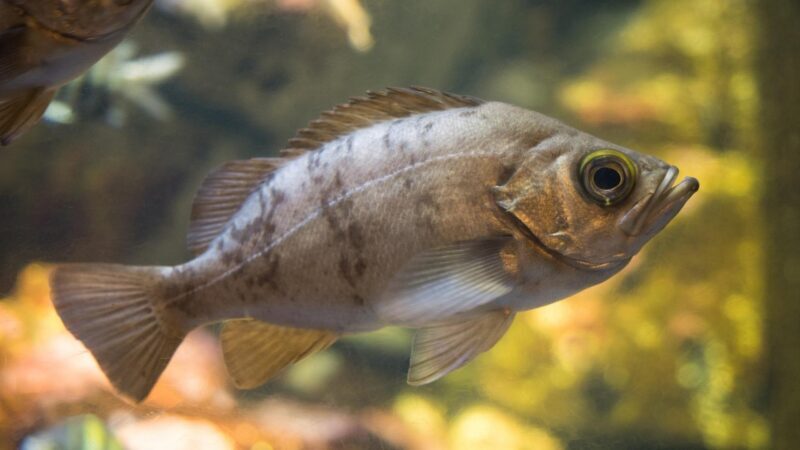
Rockfish own big eyes, long tails, and large ears. These fishes are among the most common sea creatures that you can find worldwide.
Their eyes are found on top of their head, looking like two dark circles, which are used mainly for viewing at night and catching prey.
Rock fishes have long bodies and short heads. They have a varied diet, which includes Pacific herring, shrimp, crabs, greenlings, surfperch, and benthic invertebrates like amphipods.
These fishes have over 130 species, and most of them are toxic to pets and humans due to their venomous spines.
- Scientific Name: Sebastes
- Appearance: Rockfish have various colors, including yellow, red, orange, black, dark green, and black. These fishes possess a brownish body tint with a whitish abdomen, tinged with orange or pink. Rockfish have three pores on each side of their lower jaws and two dark streaks on each cheek.
- Color: Yellow, red, black, orange, and dark green.
- Lifespan: 11 years to 200 years
- Size: 23 inches
- Weight: 770 grams
- Diet: Crabs, Pacific herring, shrimp, greenlings, surfperch, and amphipods
- Place Of Origin: Alaska and California
- Characteristics: Rockfish can float stationary in the water due to their air bladders. This fish can also be aggressive and very territorial. It is best to note not to handle these fishes since they have toxic spines.
Blue Shark
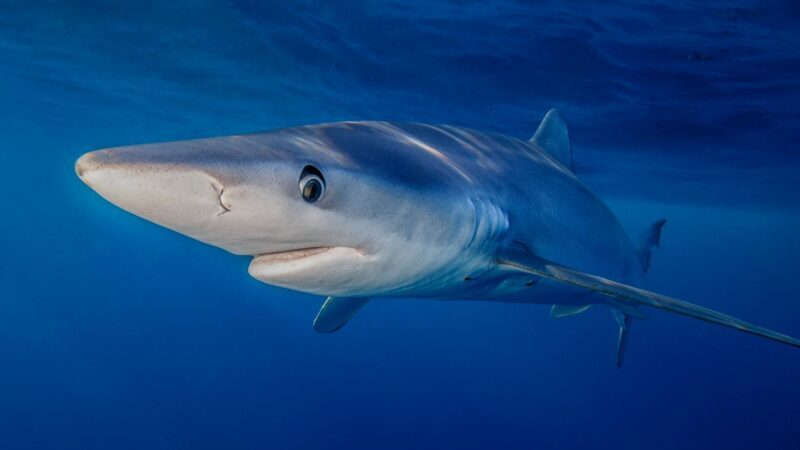
Blue sharks are another fish species with big eyes and long snouts. These fishes reside in tropical waters and eat shrimps, crabs, octopuses, squids, and other small fishes.
These fishes are among the top predators in the ocean and eat other fish. Blue sharks have large eyes that they use to detect movement in the water, allowing them to spot their prey from afar quickly.
These fish species prefer to stay on shallow coastal waters and feed on invertebrates and small fish. The blue sharks primarily feed on squid, herring, and carcasses of turtles and whales.
Obviously, these fishes can’t be pets since they are predators and belong in the vast ocean.
- Scientific Name: Prionace glauca
- Appearance: Blue sharks are massive creatures that can reach up to 13 feet in length but typically are nearer to 10 feet long. These fishes have deep blue dorsal color, fading to light blue on each side and white on the bellies. Blue sharks have slim bodies with cone-shaped snouts and large eyes.
- Color: Dark blue
- Lifespan: 20 years
- Size: 13 feet
- Weight: 110 kilograms
- Diet: Squid, herring, turtles, and whales
- Place Of Origin: Norway and Chile
- Characteristics: Blue sharks have lean bodies with large eyes and long snouts, longer than their mouth’s width. They have excessively long, pointy pectoral fins, generally as long as their snout and up to their rear gill slit.
Genie’s Dogfish
Genie’s Dogfish possess big, round eyes and a mouth filled with sharp teeth. This fish species has one of the best eyesights among fish species.
Unlike other fish with limited vision, the Genie’s Dogfish can see various colors, movements, shapes, and details at night. Their eyes are sensitive to light, helping them steer through murky waters.
These fishes primarily feed on herring, shrimps, squids, and crabs. They are also preyed upon by larger shark species, such as bigger spiny dogfish, killer whales, seals, etc.
These fishes won’t make good pets since they have venom on their dorsal spines that can be mildly toxic to humans. On top of that, they also require large tanks and need huge commitment since they have a remarkably long lifespan.
- Scientific Name: Squalus clarkae
- Appearance: Genies Dogfish are cute, big-eyed dogfish shark species that are slim with elongated bodies and somewhat flattened heads.
- Color: Brownish slate
- Lifespan: 20 to 24 years on average
- Size: 6 feet long
- Weight: 200 pounds
- Diet: Herring, crabs, shrimps, and squids
- Place Of Origin: Western Atlantic and Mexico
- Characteristics: These fishes have slim, elongated bodies, relatively flattened heads, and narrow snouts. Their first dorsal fin can be found between their pelvic and pectoral fin roots.
Barracuda
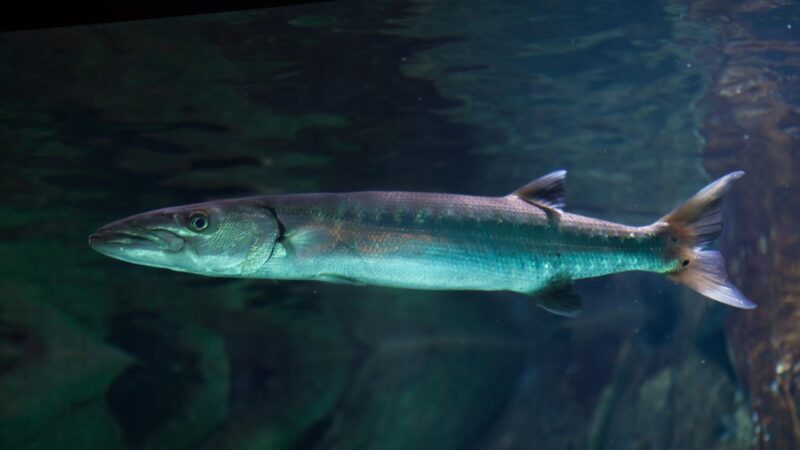
Barracudas have big eyes mainly used for hunting their prey, allowing them to see underwater. They own two large dark eyes used for hunting their prey.
The eyes of barracudas are found on top of their heads, helping them see prey and predators from afar. These fishes have sharp teeth and long snouts, allowing them to catch and feed on shrimps, small fishes, and crabs.
These fishes can be good pets, as long as you take good care of them. It’s advisable to do research about this species before getting one as a pet.
You can get one Barracuda fish as a pet starting at $170.
- Scientific Name: Sphyraena
- Appearance: Barracudas have a snake-like appearance with notable, sharp fang-like teeth—comparable to that of piranhas. These fishes have large jaws, pointed heads, gills with no spine coverings, and small scales.
- Color: Bluish-gray or brownish
- Lifespan: 14 years
- Size: 23 inches
- Weight: 24 kilograms
- Diet: Herrings, grunts, jacks, small tunas, snappers, killifishes, mullets, and anchovies
- Place Of Origin: Massachusetts and Brazil
- Characteristics: Barracudas are hardy fishes with sleek, torpedo-shaped bodies and remarkable razor-sharp teeth set. Their lower jaw extends out past the upper jaw, which is both loaded with dozens of teeth.
Spotted Ratfish

Spotted ratfish are among the fishes with big eyes, small mouths, and long snouts. Their bodies are covered in spots, helping them harmonize with their environment.
Their coloration also helps them greatly to hide from predators such as sharks and other bigger fish. These fishes have two large eyes on top of their head, and they can be generally found in tropical waters worldwide.
Spotted ratfish favor areas close to coral reefs and rocky shores. These fishes are also generalist predators that eat various invertebrates and fishes found on the seafloor.
These fishes are not ideal, as pets since they are highly aggressive, especially if anyone invades their space. They can also induce mild toxic wounds to humans using their dorsal fins.
- Scientific Name: Hydrolagus colliei
- Appearance: This particular fish with big eyes has large glowing green eyes, scaleless skin, a mouth with plate-like, gnawing teeth, and a rabbitlike face. The tail is relatively small, so they flutter their big, wing-like pectoral fins for thrusting.
- Color: Silvery-bronze
- Lifespan: 16 years (Males), 21 years (Females)
- Size: 23.6 inches in length
- Weight: 3.90 pounds
- Diet: Fishes and invertebrates
- Place Of Origin: West coast of North America
- Characteristics: The spotted ratfish has a very unique look to other unrelated fish species with spots around their bodies. This fish species mostly just move above the seafloor, scouring for crunchy meals like clams and crabs.
Tarpon

Tarpons have large eyes that greatly help them to see underwater. These fishes typically live in freshwaters like lakes and rivers and are native to South America and Florida.
They are also the largest species of saltwater gamefish in the world, with a varied diet that includes shrimps, crabs, small fishes, and other crustaceans. They also prey on rays and smaller sharks.
In general, these fishes won’t make good pets since they have never been domesticated by humans.
- Scientific Name: Megalops
- Appearance: Tarpons have distinct large scales covering their sides and feature a bright, lustrous color, making them flash and glow in the sunlight. They also own long bodies with big pelvic fins and elongated pectoral fins.
- Color: Greenish-black to dark-blue
- Lifespan: 50 years
- Size: 8 feet
- Weight: 200 pounds
- Diet: Carnivorous (marine catfishes, pinfish, Atlantic needlefish, mullets, sardines, crabs, and shrimp)
- Place Of Origin: South America and Florida
- Characteristics: Tarpons have anal and dorsal downy rays with greenish or bluish backs. These fishes also have glossy, silvery scales covering the majority of their bodies, except the head.
Horse-Eye Jack
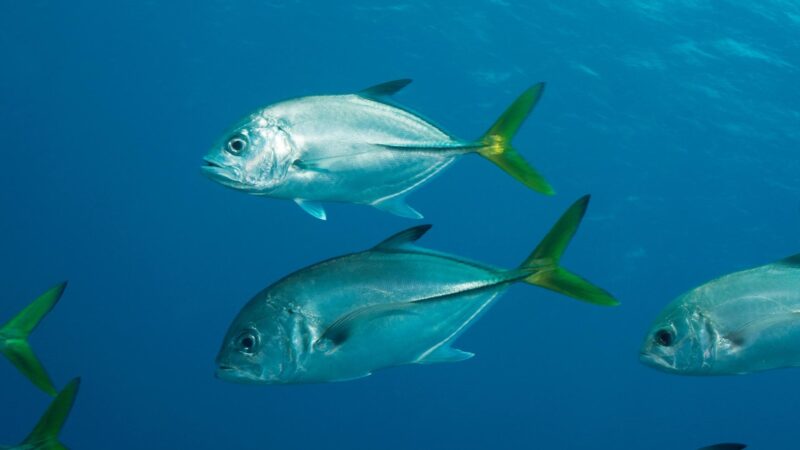
Horse-eye jacks are small freshwater fishes native to South America. The large eyes are found on top of their heads, looking like a horse’s eye.
These fishes reside in shallow water, where they can quickly see predators. This helps them escape danger right away when they see it.
In terms of diet, the horse-eye jacks are carnivorous and feast on small fishes, tiny invertebrates, and shrimps. These fishes can’t be god pets since their size can get too large for a regular home aquarium.
- Scientific Name: Caranx latus
- Appearance: The adult horse-eye jack is generally silvery blue to dark blue on the upper parts and silvery-white to golden beneath. Some individuals have soft dorsal fins lobe and dark blue to black scutes.
- Color: Silvery blue to dark blue and silvery-white to golden
- Lifespan: 25 years to 30 years
- Size: 40 inches in length
- Weight: 13.4 kilograms
- Diet: Tiny invertebrates, shrimps, and small fishes
- Place Of Origin: South America
- Characteristics: Horse-eye jacks are large fishes with a similar body build to other large jacks. They own relatively compact and elongated bodies.
Bigeye Fish
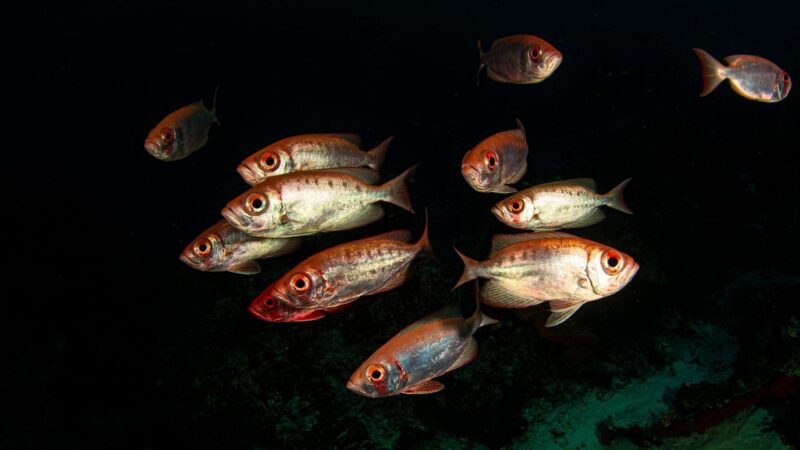
The bigeye fish belongs to the priacanthidae family, including approximately 50 small, deepwater fish species. They are bottom dwellers that feed on crustaceans, mollusks, and other small invertebrates.
This fish family is among the largest fish species around the world. These fishes are typically found in tropical waters around the globe, covering the Indian Ocean and the Pacific Ocean.
These fishes are predominantly nocturnal predators, but some individuals can be seen active during the day. Young bigeye fishes prey mostly on crustaceans, such as euphausiids and decapods, while adults normally feast on fish juveniles, and larvae.
These fishes can be kept as pets, but the knowledge that they can be good pets is still questionable.
- Scientific Name: Priacanthus macracanthus
- Appearance: Bigeye fishes are usually bright red in color, but most species can vary from a light shade to a deep, spotted coloring. You can mostly find these fishes in tropical and subtropical environments in most oceans.
- Color: Bright red
- Lifespan: 9 years on average
- Size: 12 inches
- Weight: 11 grams to 1 kilogram
- Diet: Small benthic invertebrates, zooplankton, and fish larvae
- Place Of Origin: Southern Japan and Western Indonesia
- Characteristics: Big-eyes are medium-sized fishes with relatively deep bodies, oblique mouths, huge eyes, and lower jaws flinging upwards. Their bodies taper slightly underneath the middle of the smooth part of the dorsal fin and unexpectedly to the peduncle.
Telescope Goldfish
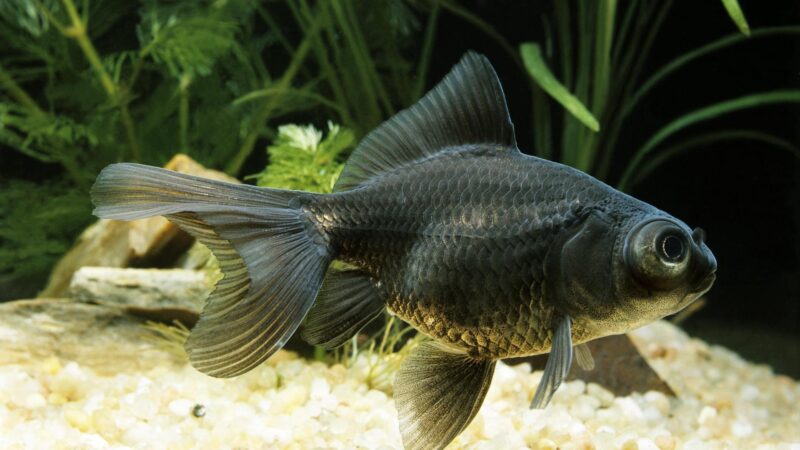
The telescope goldfish are extremely curious fish with big, round eyes, helping them see nicely in murky waters. They also have a broad mouth for consuming food.
These fishes typically eat all kinds of frozen, fresh, and flake foods. It’s also good to treat them with daphnia, brine shrimp, tubifex worms, and blood worms.
These fishes are popular as pets and can make a great addition to the pet fishes you have in your aquarium. You can buy one at pet stores, starting from $15 to $25 each.
- Scientific Name: Carassius auratus auratus
- Appearance: The telescope eye is a goldfish best determined by its protruding eyes. It was first developed in China in the early 1700s, where this feature was usually referred to as dragon eyes.
- Color: Dark brown, black, red, orange, red-and-white, white, calico, or tri-colored
- Lifespan: 6 years to 25 years
- Size: 4 inches to 10 inches
- Weight: 9.9 pounds
- Diet: All kinds of frozen, fresh, and flake foods
- Place Of Origin: China
- Characteristics: Telescope goldfishes have bodies and heads very identical to the Fantail, which are usually egg-shaped. The depth of their bodies is ideally larger, and their tail fin comes in diverse variations, such as veiltail, broadtail, or butterfly tail.
Porbeagle Shark
The porbeagle sharks possess big eyes that are very useful for hunting food. On top of that, they also own large teeth, helping them catch prey easily.
Porbeagle sharks also have two rows of huge, circular lenses dubbed “eyeballs,” allowing them to see clearly underwater and detect prey even if it’s 1 kilometer away.
These fishes have a unique ability to notice electromagnetic fields, allowing them to hunt at night. These fishes live in the Atlantic Ocean, ranging from Brazil to North Carolina.
These sharks primarily feast on hake, mackerel, cod, herring, and dogfish when they mature. Unlike its larger families in the white shark, they do not prey on other aquatic mammals.
Naturally, these huge predatory fishes won’t make good pets.
- Scientific Name: Lamna nasus
- Appearance: Porbeagles are muscular sharks with spindle-like shapes. They are best determined by their blue-gray bodies and whitish stomach areas. They also have distinct blue-gray dorsal fins with a white spot on their posterior base.
- Color: Bluish-gray
- Lifespan: 30 years
- Size: 11.6 feet long
- Weight: 130 kilograms
- Diet: Mackerel, cod herring, dogfish, and hake
- Place Of Origin: North Carolina and Brazil
- Characteristics: Porbeagles are bulky enormous sharks with pointed snouts, large black eyes, and relatively small, pointy slim teeth.
Swordfish
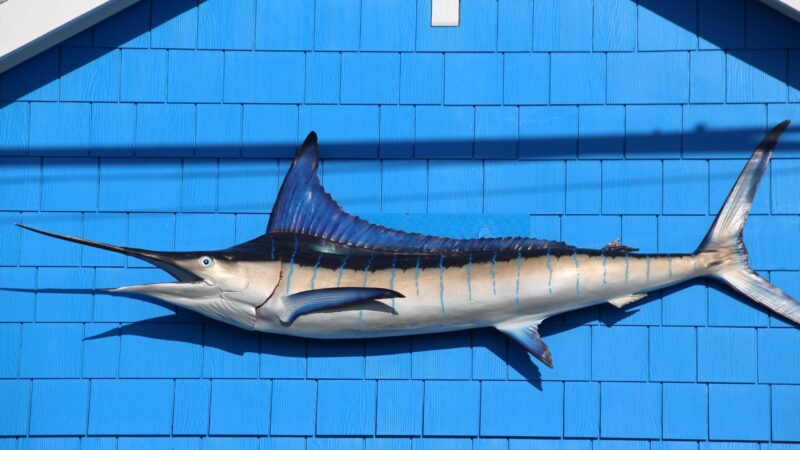
Swordfish are among the fish species with big eyes. They also own big mouths, and tiny brains and usually live in cold waters.
On top of that, they also own a pair of barbels, which are short whiskers. These whiskers help them find their food quickly.
Swordfish reside in tropical oceans globally—from the vast Indian Ocean to the far Pacific Ocean. It’s best to note that these fishes are only found at depths between 100 meters and 1,500 meters.
These fishes do not make suitable pets since they get too large to preserve in a home aquarium.
- Scientific Name: Xiphias gladius
- Appearance: Swordfish own a long, flattened snout, which looks like a sword, where they get their name. They have plump, spherical bodies and big eyes.
- Color: Deep brown to black
- Lifespan: 9 years
- Size: 117 inches
- Weight: 650 kilograms
- Diet: Variety of invertebrates and fishes
- Place Of Origin: Greece
- Characteristics: Swordfish own special organs, located right next to their eyes, which keep their eyes and brain warm in cold water. This attribute significantly enhances their ability to see underwater.
Bigeye Tuna
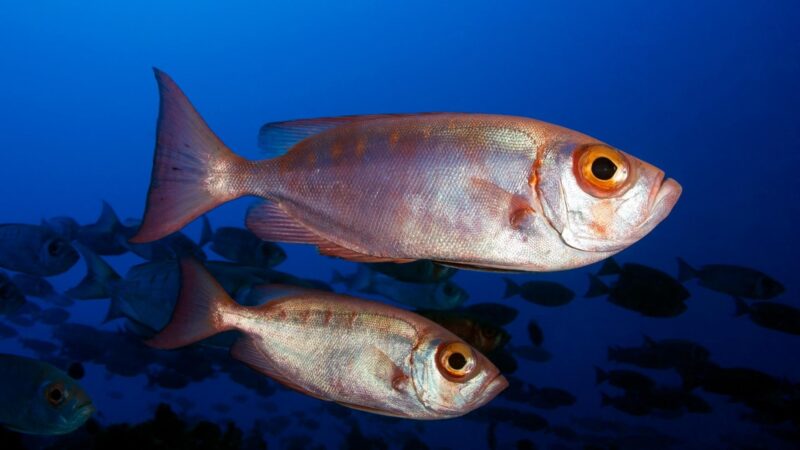
Bigeye tuna primarily lives in the Pacific Ocean and is found between 1,000 and 4,000 meters in depth. They have large eyes covering nearly half of their heads.
They live at depths between 500 and 2,000 meters, where they feast on small fishes like sardines, anchovies, mackerels, squids, herring, and crustaceans. This fish can’t be kept as a pet since they get excessively large to retain in a home aquarium.
- Scientific Name: Thunnus obesus
- Appearance: The bigeye tuna are among the largest tuna species, reaching up to 8 feet and weighing 200 kilograms. They have dark blue to black backs with white lower sides and bellies.
- Color: Metallic blue
- Lifespan: 30 years
- Size: 8 feet
- Weight: 200 kilograms
- Diet: Sardines, herring, mackerels, squid, anchovies, and crustaceans
- Place Of Origin: Western and Eastern Atlantic Ocean
- Characteristics: Bigeye tuna have distinctly torpedo-shaped bodies, whitish lower bellies, sides, and dark metallic blue backs. Both anal and dorsal fins have a yellow tint with bright yellow finlets.
Bigeye Thresher Shark

The bigeye thresher shark is a huge shark that is generally considered harmless. However, it is still best to avoid these fish species due to their massive size.
These sharks can grow up to 20 feet maximum in length. You can sometimes see these sharks leaping out of the seawater and occasionally mistaken for other marine mammals.
The bigeye thresher typically feeds on pelagic and benthic fish such as lancetfishes, tuna, hake, young billfish, and herring. They can also feed on various crustaceans and squids.
Undeniably, these fishes won’t make good pets.
- Scientific Name: Alopias superciliosus
- Appearance: Thresher sharks own huge eyes, big pectoral fins, small mouths, first pelvic fins, and dorsal. They also have a small secondary dorsal fin located close to their tails and anal fins.
- Color: Gray, brown, blue, or purplish
- Lifespan: 20 years
- Size: 11 years to 13 years
- Weight: 160 kilograms
- Diet: Tuna, hake, lancet fishes, young billfish, and herring
- Place Of Origin: Newfoundland to Cuba
- Characteristics: The most apparent characteristic of bigeye thresher sharks in the top lobe of their tails are oddly long and very whip-like. They usually use their tails to stun and herd small fishes, basically preying on them.
Squirrel Fish
Squirrel fishes have big eyes, helping them see much better at night. On top of that, they also have a wonderful sense of taste and smell.
These fishes have two sets of eyes, one set meant for seeing past the water and another set for viewing below. This feature allows them to see what’s occurring above and below the water.
In terms of diet, they are carnivores that feed on various crustaceans, like crabs and shrimps, serpent and brittle stars, marine worms, and other invertebrates.
This species can be kept as pets, but you won’t likely see them that much even if you put these fishes in If you keep this fish in a brightly lit aquarium. This is because they tend to hide and go out only when it’s dark due to their nocturnal nature.
To enjoy these fishes as pets, consider keeping them in low lighting.
- Scientific Name: Holocentridae
- Appearance: Squirrelfish have vibrant-colored bodies that usually shine and have unequal large, black eyes. These fishes also have lighter-colored bellies, allowing them to blend into their surroundings when viewed beneath the surface.
- Color: Red
- Lifespan: 2 years to 4 years
- Size: 7.8 inches
- Weight: 2.6 kilograms
- Diet: Shrimps, crabs, marine worms, serpent stars, and other moving invertebrates
- Place Of Origin: The Gulf of Mexico and Southwestern Atlantic Ocean
- Characteristics: Squirrelfish are palatable fish found in the tropics. They have rough and spiny fins with thorny scales. Some even have a sharp spine on their cheeks with various white, yellow, or black markings.
Red Big Eye
The red big eye fish is part of the 18 species of the marine ray-finned fish family with large eyes. These fishes are nocturnal and carnivorous.
Their primary diet includes sand-dwelling worms and shrimps. They usually have bright red colors with silver, black, and dusky brown patterns.
These fishes can be pets, but it’s unknown if they can be good pet fish.
- Scientific Name: Priacanthus macracanthus
- Appearance: Juveniles own a dark mottled look when freshly captured, but larger species are plain red with light-colored fins and dark yellow-green mark rows.
- Color: Red
- Lifespan: 2 years
- Size: 12 inches
- Weight: 0.4 kg to 2 kg
- Diet: Sand-dwelling worms and shrimps
- Place Of Origin: Australia
- Characteristics: Red big eye species are stout with compacted bodies, a straight dorsal fin, and unduly large snoots.
Frequently Asked Questions
What Fish Has the Best Eyesight?
The fish with the best eyesight is the cuatro Ojos or Brazil’s four-eyed fish. This fish has an incredible visual system and usually has four eyes, but split into two pairs—one pair for seeing the surface above, while the other two are used beneath the water.
Why Do Fish Eyes Pop Out?
When the fish’s eyes pop out, this is caused by an infection, injury, or low-grade water conditions in the aquarium. Infections can be generated by various organisms, including fungi, bacteria, and parasites.
Is It Safe to Eat Fish With Red Eyes?
It is generally safe to eat fish with red eyes. This is because the fish eyes are not often the best quality indicator.
For instance, fresh fish can still have cloudy or bloody eyes due to mishandling. This means that even if the fish has bloody eyes, they can still be good fish to eat.
Summary
So, there you have it—the 15 fish with big eyes! If you are particularly looking for some fish with pretty big eyes that can be pets, you can always refer to this guide.
List of Sources
Rockfish. Washington Department of Fish and Wildlife.
Learn about blue sharks. Commonwealth of Massachusetts.
Milisen, J. Growing up a Swordfish. Smithsonian.
Bigeye tuna. Australian Government – Australian Fisheries Management Authority.
